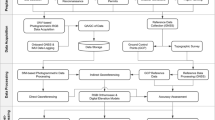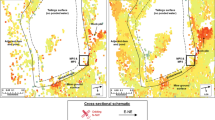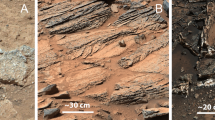Abstract
The Structure from Motion (\({\text{SfM}}\)) photogrammetric technique has emerged as an efficient alternative for remote 3D rock characterization, compared to laser scanner (LiDAR) or stereoscopic photogrammetry, due to its economy and ease of use. This work uses a terrestrial \({\text{SfM}}\) approach, in combinations with telephoto lens, to characterize joint roughness at long range, in which photographs are taken at some distance from the slope. To that end, we employ the \({\text{SfM}}\) technique, combined with telephoto lenses (\(f = 200 \;{\text{mm}}\)), to quantify joint roughness in a slope. Roughness profiles are extracted from the 3D model of the slope, and their \(Z_{2}\) statistical parameter is used to estimate the Joint Roughness Coefficient (\({\text{JRC}}\)). We also study the influence of several operational \({\text{SfM}}\) parameters—e.g. focal length, analysis distance and number of photographs—on the roughness results. Results show that the \({\text{SfM}}\) technique using photographs taken with telephoto lens can be employed to characterize joint roughness at a relatively large distance (up to 10–15 m), with \({\text{JRC}}\) estimates that are similar to those obtained at close range (\(\simeq 1 \;{\text{m}}\)). Furthermore, results reveal that only a few photographs are needed to generate 3D models that provide reasonable \({\text{JRC}}\) estimates, hence facilitating the applicability of the \({\text{SfM}}\) technique to quantify joint roughness in practice, since such low number of photographs is associated with short processing times (\(< 5 \;{\text{min}}\)) and reduced periods for data acquisition in the field (\(< 15 \;{\text{min}}\)).









Similar content being viewed by others
Abbreviations
- \({\text{SfM}}\) :
-
Structure from motion
- \({\text{JRC}}\) :
-
Joint roughness coefficient
- \({\text{GCP}}\) :
-
Ground control point
- \({\text{DPC}}\) :
-
Disperse point cloud
- \({\text{HDPC}}\) :
-
High density point cloud
- \({\text{ROI}}\) :
-
Region of interest
- \({\text{CRP}}\) :
-
Close range photogrammetry
- \({\text{UAV}}\) :
-
Unmanned aerial vehicle
- \(f\) :
-
Focal length
- \(A_{n}\) :
-
Analysis Area
- \({\text{Prof}}_{i}^{{A_{n} }}\) :
-
Roughness profile
- \(R_{{\text{a}}}\) :
-
Mean roughness
- \(L\) :
-
Profile length
- \(Z_{2}\) :
-
Average quadratic slope
References
Alameda-Hernández P, El Hamdouni R, Irigaray C, Chacón J (2019) Weak foliated rock slope stability analysis with ultra-close-range terrestrial digital photogrammetry. B Eng Geol Environ 78(2):1157–1171. https://doi.org/10.1007/s10064-017-1119-z
Barton N (1973) Review of a new shear-strength criterion for rock joints. Eng Geol 7(4):287–332. https://doi.org/10.1016/0013-7952(73)90013-6
Barton N, Choubey V (1977) The shear strength of rock joints in theory and practice. Rock Mech 10(1–2):1–54. https://doi.org/10.1007/BF01261801
Beer AJ, Stead D, Coggan JS (2002) Estimation of the Joint Roughness Coefficient (JRC) by visual comparison. Rock Mech Rock Eng 35(1):65–74. https://doi.org/10.1007/s006030200009
Eltner A, Kaiser A, Castillo C, Rock G, Neugirg F, Abellán A (2016) Image-based surface reconstruction in geomorphometry-merits, limits and developments. Earth Surf Dyn 4(2):359–389. https://doi.org/10.5194/esurf-4-359-2016
García-Luna R, Senent S, Jurado-Piña R, Jimenez R (2019) Structure from Motion photogrammetry to characterize underground rock masses: Experiences from two real tunnels. Tunn Undergr Sp Tech 83:262–273. https://doi.org/10.1016/j.tust.2018.09.026
Ge Y, Kulatilake PH, Tang H, Xiong C (2014) Investigation of natural rock joint roughness. Comput Geotech 55:290–305. https://doi.org/10.1016/j.compgeo.2013.09.015
Guo H, Karekal S, Poropat G, Soole P, Lambert C (2011) Pit wall strength estimation with 3D imaging. CSIRO project paper, ACARP Proyect, p C18030
Haneberg WC (2007) Directional roughness profiles from three-dimensional photogrammetric or laser scanner point clouds. In: Eberhardt E, Stead D, Morrison T (eds) Rock Mechanics: Meeting Society’s Challenges and Demands 1:101–106. https://https://doi.org/10.1201/noe0415444019-c13
Hsiung SM, Ghosh A, Ahola MP, Chowdhury AH (1993) Assessment of conventional methodologies for joint roughness coefficient determination. Int J Rock Mech Min Sci Geomech Abstr 30(7):825–829. https://doi.org/10.1016/0148-9062(93)90030-H
Kim DH, Gratchev I, Poropat G (2013) The determination of joint roughness coefficient using three-dimensional models for slope stability analysis. In: Dight PM (ed) Proceedings of slope stability, Australian Centre for Geomechanics, Brisbane, Australia, pp 281–289
Li Y, Zhang Y (2015) Quantitative estimation of joint roughness coefficient using statistical parameters. Int J Rock Mech Min Sci 100(77):27–35. https://doi.org/10.1016/j.ijrmms.2015.03.016
LLC A (2016) Agisoft PhotoScan user manual-professional edition, St Petersburg, Russia, Version 1.2
Maerz N, Franklin J, Bennett C (1990) Joint roughness measurement using shadow profilometry. Int J Rock Mech Min Sci Geomech Abstr 27(5):329–343. https://doi.org/10.1016/0148-9062(90)92708-M
Merino-Tomé O, Suárez-Rodriguez A, Alongo-Alonso JL Mapa Geológico (2019) Digital continuo E. 1: 50.000, Zona Cantábrica (Zona-1000). In: GEODE. Mapa Geológico Digital continuo de España. [online]. [16–12–2019]. http://info.igme.es/cartografiadigital/geologica/geodezona.aspx?id=Z1000. Accessed 16 Dec 2019
Patton FD (1966) Multiple modes of shear failure in rock. In: Proceedings of the 1st ISRM Congress, International Society for Rock Mechanics and Rock Engineering, Lisbon, Portugal 509–513
Poropat GV (2008) Remote characterisation of surface roughness of rock discontinuities. In: Potvin Y, Carter J, Dyskin A, Jeffrey R (eds) SHIRMS 2008: Proceedings of the 1st Southern Hemisphere International Rock Mechanics Symposium, Australian Centre for Geomechanics, Perth, Australia 447–458
Poropat GV (2009) Measurement of surface roughness of rock discontinuities. In: Diederichs M, Grasselli G (eds) ROCKENG09: Proceedings of the 3rd CANUS Rock Mechanics Symposium, Toronto, Canada, pp 1–9
Russell W (2016) Calculating the Uncertainty of a Structure from Motion (SfM) Model, Cadman Quarry. MSc Thesis, University of Washington, USA
Salvini R, Vanneschi C, Coggan JS, Mastrorocco G (2020) Evaluation of the use of UAV Photogrammetry for rock discontinuity roughness characterization. Rock Mech Rock Eng 53:3699–3720. https://doi.org/10.1007/s00603-020-02130-2
Snavely N, Seitz SM, Szeliski R (2008) Modeling the world from internet photo collections. Int J Comput Vis 80(2):189–210. https://doi.org/10.1007/s11263-007-0107-3
Spetsakis M, Aloimonos JY (1991) A multi-frame approach to visual motion perception. Int J Comput Vision 6:245–255. https://doi.org/10.1007/BF00115698
Stigsson M, Ivars DM (2019) A novel conceptual approach to objectively determine JRC using fractal dimension and asperity distribution of mapped fracture traces. Rock Mech Rock Eng 52(4):1041–1054. https://doi.org/10.1007/s00603-018-1651-6
Sturzenegger M (2010) Multi-scale characterization of rock mass discontinuities and rock slope geometry using terrestrial remote sensing techniques. PhD Thesis, Simon Fraser University, BC, Canada
Sturzenegger M, Stead D (2009a) Quantifying discontinuity orientation and persistence on high mountain rock slopes and large landslides using terrestrial remote sensing techniques. Nat Hazards Earth Syst Sci 9(2):267–287. https://doi.org/10.5194/nhess-9-267-2009
Sturzenegger M, Stead D (2009b) Close-range terrestrial digital photogrammetry and terrestrial laser scanning for discontinuity characterization on rock cuts. Eng Geol 106(3–4):163–182. https://doi.org/10.1016/j.enggeo.2009.03.004
Sturzenegger M, Stead D, Beveridge A, Lee S (2009) Long-range terrestrial digital photogrammetry for discontinuity characterization at Palabora open-pit mine. In: Diederichs M, Grasselli G (eds) ROCKEN09: proceedings of the 3rd CANUS Rock Mechanics Symposium, Toronto, Canada 1–10
Tatone B (2009) Quantitative characterization of natural rock discontinuity roughness in-situ and in the laboratory. MSc Thesis, University of Toronto, Canada
The Mathworks Inc. (2019) MATLAB (MATrix LABoratory), Version 9.6 (R2019a)
Tse R, Cruden DM (1979) Estimating joint roughness coefficients. Int J Rock Mech Min Sci Geomech Abstr 16:303–307. https://doi.org/10.1016/0148-9062(79)90241-9
Unal M, Unver B (2004) Characterization of rock joint surface degradation under shear loads. Int J Rock Mech Min Sci 41(3):380–381. https://doi.org/10.1016/j.ijrmms.2004.03.033
Verma AK, Bourke MC (2019) A method based on structure-from-motion photogrammetry to generate sub-millimetre-resolution digital elevation models for investigating rock breakdown features. Earth Surf Dyn 7:45–66. https://doi.org/10.5194/esurf-7-45-2019
Wernecke C, Marsch K (2015) Mapping rock surface roughness with photogrammetry. In: Schubert W, Kluckner A (eds) ISRM Regional Symposium-EUROCK 2015. International Society for Rock Mechanics and Rock Engineering, Salzburg, pp 1175–1180
Wolter A, Stead D, Clague JJ (2014) A morphologic characterisation of the 1963 Vajont Slide, Italy, using long-range terrestrial photogrammetry. Geomorphology 206:147–164. https://doi.org/10.1016/j.geomorph.2013.10.006
Acknowledgements
This research has been funded by the Spanish Ministry of Economy and Competitiveness, under Grant Number BIA2015-69152-R. This support is gratefully acknowledged.
Funding
This research has been funded by the Spanish Ministry of Economy and Competitiveness, under Grant Number BIA2015-69152-R.
Author information
Authors and Affiliations
Corresponding author
Ethics declarations
Conflicts of Interest
The authors declare that they have no conflict of interest.
Additional information
Publisher's Note
Springer Nature remains neutral with regard to jurisdictional claims in published maps and institutional affiliations.
Rights and permissions
About this article
Cite this article
García-Luna, R., Senent, S. & Jimenez, R. Using Telephoto Lens to Characterize Rock Surface Roughness in SfM Models. Rock Mech Rock Eng 54, 2369–2382 (2021). https://doi.org/10.1007/s00603-021-02373-7
Received:
Accepted:
Published:
Issue Date:
DOI: https://doi.org/10.1007/s00603-021-02373-7




